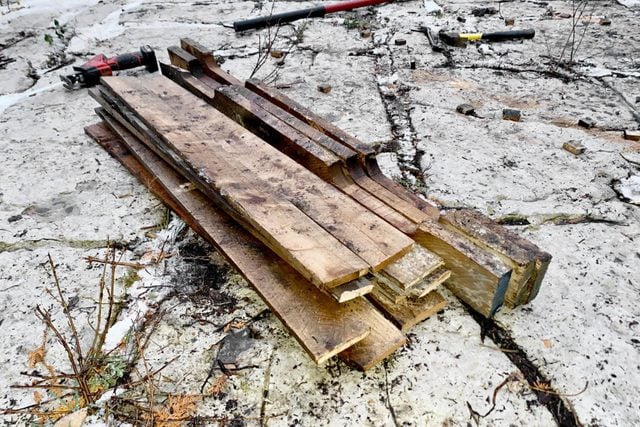Knowing how to break down a wood pallet without injury is the first step to turning it into a DIY project.
Less than 30 minutes
Beginner
Free
Introduction
Wood shipping pallets are rectangular platforms that protect and contain heavy items or stacks of items during transport. Some pallets have a second life as free or purchased material for creative DIYers and woodworkers everywhere.
Shipping pallets are made of multiple thin boards nailed together over three or four perpendicular stringer pieces. Most in North America are 48- by 40-inches. Pallets can hardwood or softwood. Hardwood pallets are tougher and harder to break so you'll probably get the best yield of wood from these rather than softwood.
The platform boards are usually 3-1/2-in. wide and vary in thickness from 5/16- to 1/2-inch. Stringer pieces range from 3/4- to 1-1/2-in. thick and average three inches in vertical width, although exact dimensions vary. From each pallet, you can expect to retrieve 10 to 12 boards around 36- to 40-in. long, 3-1/2-in. wide and 1/2-in. thick. You'll also get three or four stinger pieces.
Good shipping pallets are substantial, which is one reason DIYers have long embraced them as a source of free wood. Do a quick Google search for "reclaimed pallet projects" and you'll see dozens of beautiful benches, tables, chairs, shelves, boxes and more, all made of wood reclaimed from pallets. If you're interested in using pallet wood for a project, learning how to break one down safely and efficiently is the first step.
A few words of warning before you start:
- Pallet wood is sometimes low quality, and can be infested with bugs, rot, mold and mildew. Pass on pallets with any of these problems.
- Pallets aren't usually treated with dangerous chemicals. But they often break during use, leaving sharp slivers of wood that can hurt you. We recommend wearing tough leather gloves when handling pallets.
- Almost all pallets come with rusty nails protruding somewhere. Take extra care to avoid cutting yourself on these.
- Pallets are too large to fit in the trunks of most cars, so you'll probably need to a pickup truck for transport. Or ask someone to deliver the pallets to your home.
Once you've found enough pallets for your project — local construction companies and hardware stores can be great sources, but be sure to ask permission — gather the proper tools and get started.
Tools Required
- Clawed framing hammer
- Handsaw or circular saw
- Hearing protection
- Large can or bucket
- Leather gloves
- Pallet busting tool
- Reciprocating saw with metal cutting blade
- Safety glasses
- Sharpie marker
- Truck or ATV with trailer to transport the wood (if you're not working in or near your shop)
Materials Required
- Wooden shipping pallets (enough for the project you have in mind)
Project step-by-step (6)
Choose a good pallet
- Select a pallet that’s in good condition (not broken, rotten, oily or moldy). A visual inspection is usually sufficient to rule out these defects.
- Inspect the ends of the boards for splits and knots. Avoid pallets with a lot of each.
- Place an undamaged pallet on the ground with the bottom side up. The bottom has fewer boards joined to the three or four stringers.
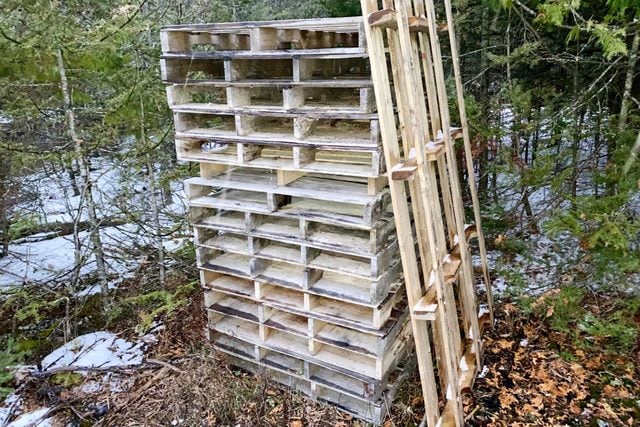
Cut the ends off the boards
Note: Wear safety glasses from this point on.
- Use a handsaw or circular saw to cut each end off all boards on the bottom of the pallet.
- Position your saw to cut off as little wood from each board, using the outer stringers as a guide. When you’re done, the boards forming the bottom of the pallet should only be fastened with the nails holding them to the central one or two stringers.
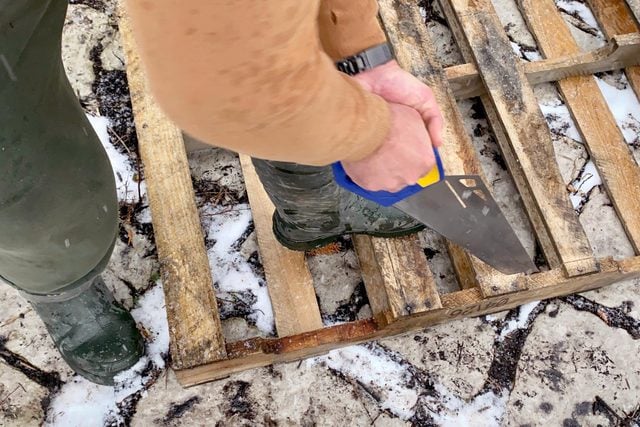
Pry the boards off the central stringer
- Stand in the middle of the pallet to weigh it down.
- Use your pallet busting tool to pry the bottom boards free of the central stringer(s).
- Free the boards by positioning the pallet buster over the stringer and directly beneath the board you want to pry off. Then pull back on the handle to create leverage.
- Collect all boards that come free without any nails in one pile, and boards with nails in another pile.
- With a hammer, pound out the nails embedded in pallet boards from the pointy end. Then pry them free with your hammer claw and drop them in a can or bucket for recycling.
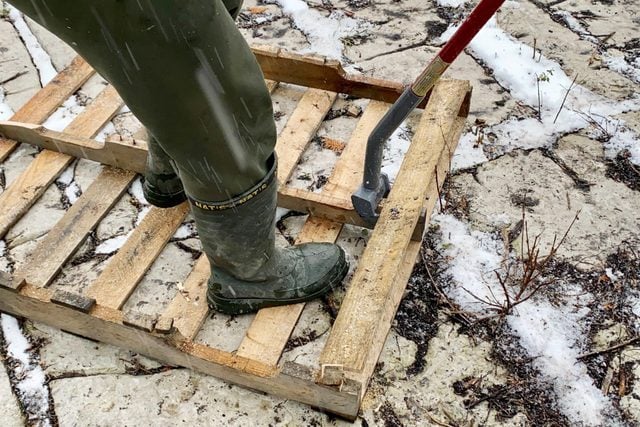
Remove the offcuts and nails
- With your claw hammer, pry off the short bits of board still nailed to the outer stringers. These will probably split and come away in pieces because they’re so short.
- Pry out the remaining nails once the offcuts have been pulled loose.
- Put on your hearing protection, grab your reciprocating saw and cut the nails off flush with the stringer if they can’t be pried out.
- Collect all nails, placing them safely in your can or bucket.
- Pound down any nails you find embedded so deeply they can’t be cut off or pulled out. Ensure these are flush with the wood’s surface. If you think you might cut up or drill into this wood, mark the spots where the nails are with a sharpie to avoid tool damage later.
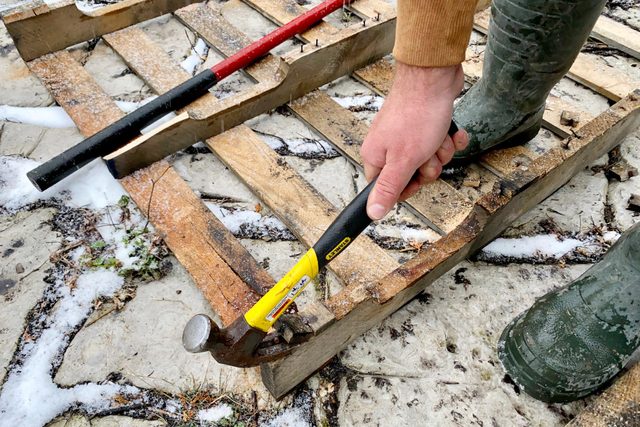
Repeat on the top side
- Flip the partially dismantled pallet over so the top side faces up.
- Cut the ends of all the top boards, as you did on the bottom side.
- Pry the boards free from the central stringers with your pallet buster tool.
- Remove all embedded nails from the pallet boards, placing them in your can or bucket.
- Pry all board offcuts free of the outer stringers.
- Pull out or cut off all nails protruding from the stringers.
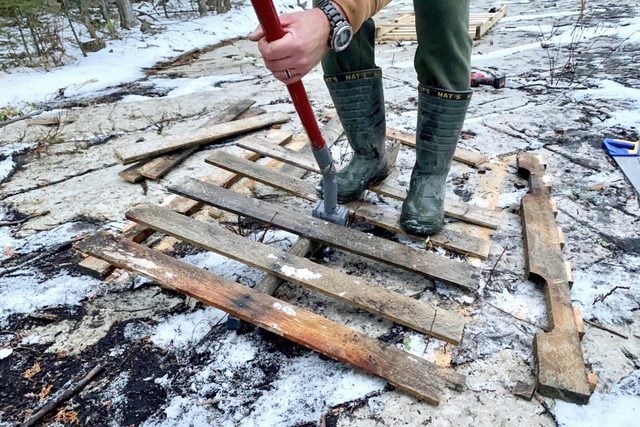
Sort and store the wood
- With the pallet dismantled, sort the wood into two piles: boards and stringers.
- Get rid of any broken, unusable pieces. They make great firewood once all the nails have been removed. If you don’t burn wood for heat, bring the pieces to your local recycling station, or have a bonfire if that’s allowed where you live.
- Store your pallet wood in a warm, dry place, like your workshop. Most pallets have high moisture content from being outside, so you should probably keep the wood indoors for a month or more before use. If your pallet was stored indoors, you’re good to go.
Here are some awesome pallet furniture ideas for you!
